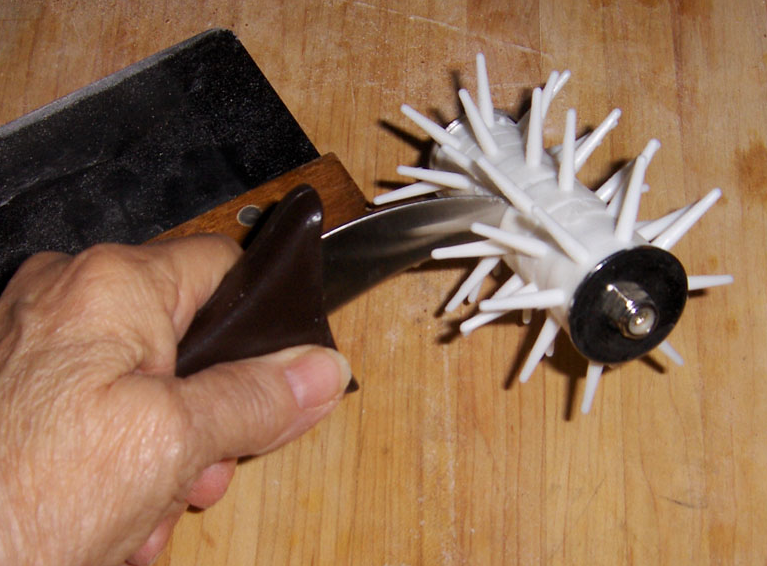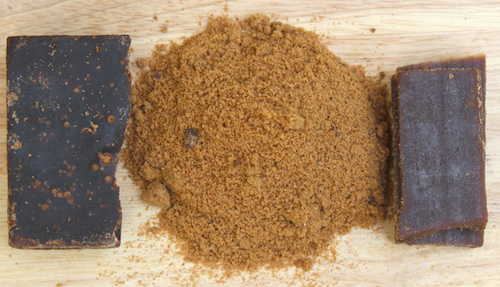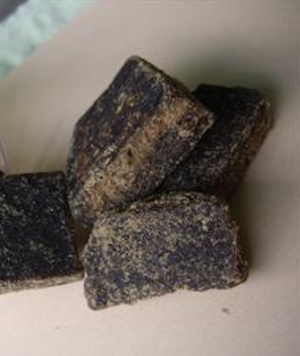-
Posts
11,034 -
Joined
-
Last visited
Content Type
Profiles
Forums
Store
Help Articles
Everything posted by andiesenji
-
The "new sorghum" fresh from the reducing pans has a higher acid content of about 4.0 ph. During storage the acidity modifies slightly and after several months will read about 5.0 to 5.5. On my grandpa's farm, the sorghum was stored in wooden kegs that had been "scorched" with charcoal (contained in a wire cage) on the inside. They were stored like wine barrels on racks. The molasses was later drained into gallon cans and sealed. Most was sold to small grocery stores in the region. There was usually a keg in the cellar with a tap for household use. Cook kept the supply for immediate use in a big enamel coffee pot that always had a cloth draped over it. My cousins and I got to feed the fires under the reducing pans. It took several days - the cane was cut and immediately hauled to the crusher because it had to be really fresh. The sap was filtered through heavy muslin cloths that were switched out and boiled in fresh water in a big old cast iron cauldron every couple of hours the funnel that fed into the dispensing pot where the kegs were filled had a stack of screens and perforated metal filters that were also cleaned in boiling water constantly. Crystals would form in the corners of the final reducing pan and the "sugar man" would scrape the stuff out and give it to us as a treat. My cousin Clark burned his arm on the edge of a pan trying to reach in and pick some out. He did not try that again.
-
After ruining part of a very expensive dish of lobster chowder many, many years ago, by doing something similar, I learned to grind my pepper into a small dish and add it to the dish with a small spoon - or by the "pinch" which gives me much more control. I was able to skim off much of the pepper but some of the lobster chunks that were floating, got peppered significantly. I rinsed them off and ate a couple but they were really peppery. I added some more heavy cream to the chowder and it was okay. Same with salt or any other spice.
-
I learned sugar work back in the '70s (before microwaves were as versatile and no silpat) I was making a spun sugar "dome" to set over a large croquembouche and as I did a pass over the top, my helper opened the door, across from me and the breeze blew the hot string over my arm. I had to set the pan I was holding in my left hand down before I could turn and get my arm under cold water. The string stuck to my arm and burned what looked like a crease the length of my forearm. At least I didn't damage the cage. I slept that night with an ice pack taped to my arm. My catering job went off without a hitch.
-
That loaf looks great.
-
This is also done in the U.S. south, at least is used to be - when I was growing up there in the 1940s. In western Kentucky, one of the "summer salads" was similar to the "Tuscan" Panzanella - just toasted bread was used instead of a rustic bread. The tomatoes were cut into chunks, sugared, often with brown sugar, and set aside to "weep" - just before serving the toast cubes - about 1 inch, were tossed with the tomatoes and chopped scallions were sprinkled over the top. It was delicious. I remember the first time I was served Panzanella - and I mentioned the tomato salad, they didn't believe it. During the winter, canned tomatoes were often layered with saltines, sprinkled with sugar and baked. This dish was called "scalloped tomatoes" and I loved it.
-
The package I have from the Middle Eastern store is a Golchin product - they produce a lot of food items, spices and such. This link is to a page of images of sugar products. They produce sugar cubes with saffron, with cinnamon, and with cardamom. Golchin sugar products. The folks there have told me that these sugars are taken with tea - holding the piece of sugar between the teeth while sipping the tea. (They also carry an impressive number of teas that are popular in the middle east)
-
Is it in a box with a parrot on it? La Perruche is carried at all the Hispanic markets here. And in the health food stores. It comes in "rough-cut" cubes and "small" cubes. The Middle Eastern market has a couple of different brands - one is made in Turkey. You can also get cubed Demerara sugar cubes - Roland is a common name and is in all the Asian shops, the India shop and one supermarket (Von's) has in in with the teas as well as in the sugar aisle. Another brand is Gilway Demerara sugar. Saint Louis Comptoir Du Sud raw sugar cubes from Martinique are sold online in a 1-kilo box. And even Domino has a product that in "gourmet shops" - Williams Sonoma used to have it. Comes in a brown box and I can't remember the product name offhand. Amazon carries the La Perruche and the Roland products.
-
Here in the U.S. I think they make the candied seeds to include in little gift boxes of candied fruits and nuts for the lunar new year. I know there are lychees and plums, melon and coconut, ginger and mandarin orange, pineapple and the lotus seeds. I think there has to be eight. I have one of the "candy boxes" someone gave me years ago and it has 8 sections. The lotus pods were grown by a "specialty grower" who was in the '80s, down near Fallbrook, CA and Peter or his brother Ji would drive down to buy them. The grower actually grew them for florists who used the dried pods in flower arrangements or wreathes, but grew some without the use of chemical fertilizers or pesticides for the ethnic communities who used them for food.
-
Your mention of a friend originally from Hunan triggered a memory for me. When I lived in Reseda, CA in the 1980s, there was a restaurant, Hunan House, just two blocks from my home and I often walked up there - going in thru the back door because it was a lot shorter than going around the block to the front. Two of the sons had been patients of the orthopedic surgeon for whom I worked so we also knew each other that way. And in fact, it was in their kitchen that I learned about steaming mature ginger to get it tender enough to candy or crystallize. On one occasion I was walking through the kitchen and saw Peter's grandmother with a large basket of fresh lotus. She was removing the seed to candy them - in "rock sugar syrup" for Chinese New Year. They did a lot of "feast day" specials in the restaurant, including the Christian holidays - they were Catholic and had escaped China just before the "revolution" in 1949, helped by the Church and they had been dedicated to paying back for 30+ years.
-
If you have time, put it in a container that seals tightly. Put a saucer or a piece of foil on the top of the sugar block. Wet a clean sponge, squeeze till it is just damp and set it on the saucer or foil. put the cover on tightly (one of the reasons I use Cambro containers or the click and seal type) the next day it will be fine. You can soften small amounts in the microwave but only do 5-10 seconds at a time, it can go from rock to lava quickly.
-

Yard Sale, Thrift Store, Junk Heap Shopping (Part 3)
andiesenji replied to a topic in Kitchen Consumer
I had one of these for awhile some years ago. It worked fine. I would run a half cup of rice mixed with a couple of tablespoons of baking soda through it to clean - and then a half cup of plain rice. It worked fine until I knocked it off the counter and several parts shattered. -
I have some antique sugar "snips" and graters - inherited from my great grandmother from the days when sugar was sold in "loaves" (actually cones). It was snipped off in chunks and then pounded in a mortar if a lot was needed. If only a little was needed, they just grated what they needed off the loaf or cone. sugar was expensive and kept locked up and used sparingly. I use a metal rasp - coarse on one side, medium on the other, to grate jaggery. In the south, when sugar was first sold granulated, and the climate was very humid. It was common to put rice in with the sugar and then put it through a "hair sieve" for use. The rice kept the sugar from clumping. My grandpa's cook was a Gullah woman from the South Carolina lowcountry and that's how she learned to store sugar and salt when she learned to cook from her mother and grandmother. She was in her late '50s when I was a child in the mid-'40s.
-
By the way. I make my own "icing sugar" by putting granulated sugar in a blender (or my Thermomix) and blending it until it is a powder. That way there are no "additives" which are common in commercial XXXXX sugar in the U.S.
-
I have all those "little gizmos" in plastic bags that HANG UP OUT OF THE WAY. The bags keep them clean and EASY TO FIND. I use shower curtain rings to hang several gadgets that are used for similar tasks. I can't tell you how much time this has saved me since I began doing it about 15 years ago when I got rid of the drawers in my kitchen because I needed slide-out shelves for bigger items. This bunch of bags usually hang over my baking center but I moved it around to this side so it is easier to see without all the other bags on that side. The docker is in one bag, a large pizza wheel I use for cutting pastry is in another, a flour duster and a press crimper in with a dough bowl scraper. I store all my mixer beaters in bags like this, one bag holds several dishers of different sizes. Even my rolling pins are in jumbo bags, hanging out of the way but are easy to access.
-
My favorite "tool" to use with pie dough is my big, rolling DOCKER, which I use on the counter after rolling it out to the correct thickness and before it is cut to size - for small pies - or draped over a pie pan for blind baking. (I bake it on the OUTSIDE of pie tins the way my grandpa's cook did 80 or 90 years ago.) Or fitted into a tart pan or ??? It's also very handy for docking crackers and some yeast rolls that require the application to flatten them prior to baking. I can't understand why everyone doesn't have one. Poking holes in dough with a fork takes way too much time.
-
This is fascinating. Having started out in my professional life as a baker, I have always been interested in how sugars are used in baked goods. But I also have followed discussions on how various cultures use different types of sugar - for preserving, for applications that "cure" fish and meats. I have a "collection" of sugars - not as extensive as my collection of salts, but there are several. I'm looking forward to further revelations so when I visit the Asian market, I will know what I am buying - because their labeling in "English" does leave much to the imagination.
-
I buy jaggery at the Indian market - I used to get it in large "cones" but now they sell it in smaller cones, in slabs and even "ground" although the latter is quite coarse. The stuff I bought at the Asian market looks like this: And I got some "Taiwan handmade black sugar" "For good health and for strong life." Looks like this. The latter is "recomend to take with ginger or ginsang tew" ? spelling. It also was entirely in Chinese characters with a sticker with the "English" printing - applied to the package.
-
Isn't it the same as bing pian tang just a different form. I have a flat block of it - Chinese cane sugar - raw, dark "bronw" from the local Asian market.
-
That's what I said at the end of the post I made ten years ago. I do have one rather expensive microplane, a box grater and I had a lot of sanding belts from when I used to do glass work so I do sharpen it. But I just by a new one when the smaller ones get dull.
-
I got a basket of unusual Asian foods a few years ago. Had to look up my thank-you note. It included a package of black buckwheat/ bitter melon noodles. The package had no English printed on it, there was a sticker with the information in English.
-
More experimenting with the Ninja Coffee Bar System. I tried the milk frother and it works okay. One has to be careful because it sputters quite a bit so one needs a deep container. I heated the milk in the microwave. The foam was adequate but my Aerolatte does better with pre-heated milk and my Capresso frothPro does MUCH BETTER! I tried a different coffee - a French roast from Lavazza, ground medium-coarse, used the permanent filter and there was much less sediment in the cup. I have a dark roast from Koffee Kult that I will grind and brew tomorrow in both the XL cup and the Half-carafe size. The commercials for this new model are now airing - on TV and on Facebook. My review on Amazon went live last evening. So far there are 10 reviews and all but one give it 5 stars.
-
That's wonderful, Lisa. I remember that the Fonellis were from the north - their family owned vineyards in the Lombardy region - they visited for a month every other year (I took care of their dogs and their fish while they were away) and they shipped cases of wine and other goodies back. I tried scanning the card to try and pull up some of the writing that is so faint but no success so far. I wrote part of it and it was a blue pen which apparently was a "fugitive" color. I think the item I thought was "tomato" is actually "torta" and possibly "salata" and I wonder if she would mean ricotta salata which would make sense because I have used it in an eggy filling for a sweet pasta "pie"
-
I found a recipe card from Nella that I think is the recipe. It is very faded and difficult to read. It is titled "EASTER PIE" The rest of the "filling" sounds right, although I can't read a couple of lines, I think there is salami and I think there may have been one layer of the flat noodles in the middle of the "stack" either above or below the greens layer that on the card says "spinach/chard" There is also a "cup" of "cerignola" which I think means the Italian sweet olives (pt + chp) which I think is pit and chop. I love those olives - I used to buy a pound (sold in bulk at the market) and eat them with a chunk of cheese for lunch. I did a Google search for Easter pie and got a bunch of results - they seem to all use pie pastry but I know she used noodles because I watched her soak them in a shallow pan, pouring hot water over them and leaving them for about half an hour. I think this one is the nearest to the recipe I have, except it does not have the layer of greens. http://www.afamilyfeast.com/easter-pie/
-
How interesting. I haven't seen these for decades. The Italian market in Canoga Park (where I lived in the late '60s and thru the '70s, carried numerous types of bulk dry pasta, sold by the pound and my Italian neighbor made a casserole using these as a "topping" Actually they started out in the bottom of the pan. She would cook them just till they were soft enough to bend, make a lattice work on the bottom of a lasagna pan. She lined the pan with greased brown paper first so the stuff would not stick when unmolded. Then layered in a very thick tomato and meat sauce, I think with ham - then a layer of cheese (?ricotta) and coarsely chopped hard-boiled eggs, a layer of greens and more eggs, another layer of cheese, maybe mozz - and then topped with wide lasagna noodles. She covered it with more oiled brown paper and baked it. It was unmolded onto a platter so the lattice work was now on top. It made a very impressive presentation. It was sort of like a quiche in the middle. I know I am leaving out some ingredients. I don't think she ever gave me the recipe.






